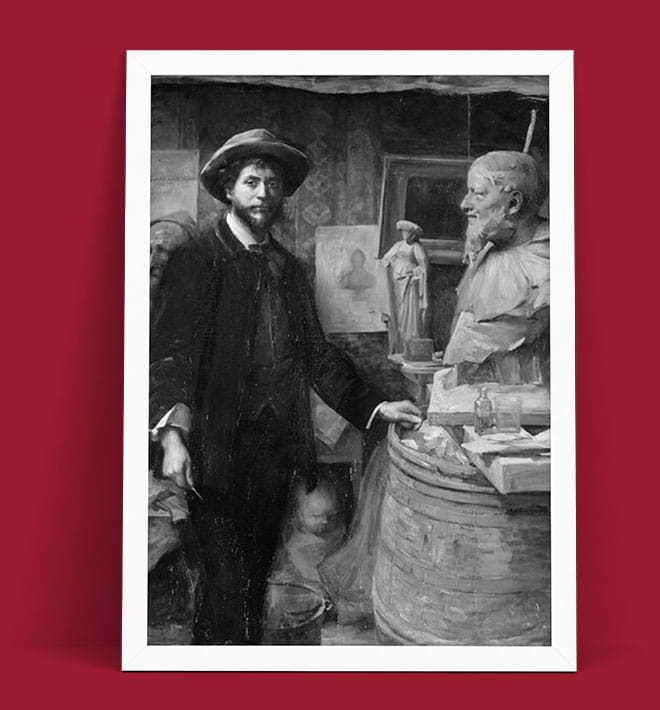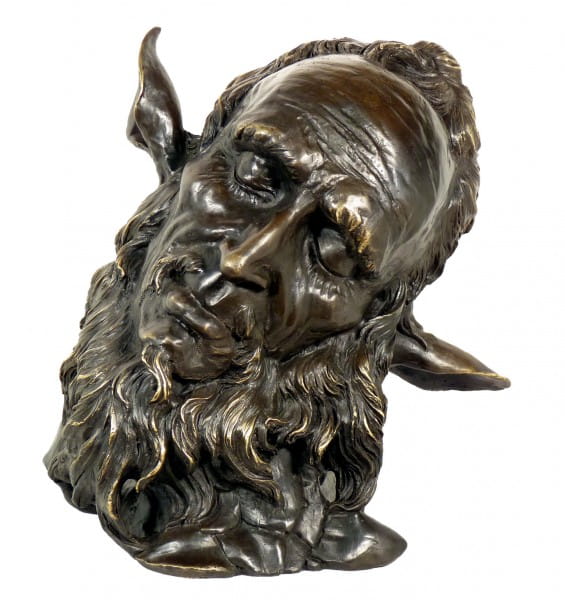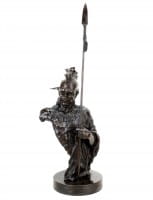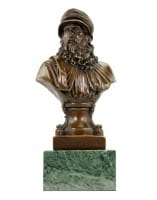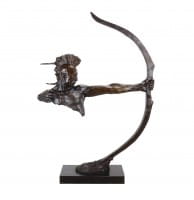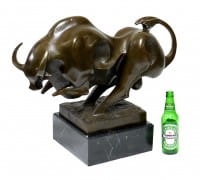Prices incl. VAT, free shipping worldwide
Ready to ship today,
Delivery time appr. 3-6 workdays










Product description
"Faun Statue - Satyr Head - Faunus - Jean Carries"
| Height | 27 cm |
| Width | 25 cm |
| Length | 19 cm |
| Weight | 5 kg |
Bronze Faun Figure – Character Head - Faunus - Signed Jean-Joseph Carriès
This striking Satyr Statue, titled Faunus, radiates an uncanny blend of raw energy and profound melancholy. Cast in bronze and signed by Jean-Joseph Carriès, the sculpture depicts the head of a Faun tilted in contemplation, its features caught between human sensitivity and animalistic instinct. The furrowed brow, closed eyes, and expressive mouth evoke both suffering and transcendence — a moment where nature’s wildness and man’s introspection converge. The pointed ears and flowing beard identify the creature as the woodland deity Faunus, whose presence in Carriès’ work symbolizes a return to primal emotion and mystery. This Faun Statue stands as a powerful exploration of character, psychology, and mythic identity — its bronze surface alive with subtle highlights that capture the duality of beauty and unrest.
The Visionary Behind the Sculpture
Jean-Joseph Carriès was born on February 15, 1855, in Lyon, France, to a modest family. Orphaned at a young age, he was raised in an orphanage before studying sculpture at the École des Beaux-Arts in Paris under Augustin Dumont. His early experiences of hardship shaped his fascination with expressive faces and intense emotional realism. Carriès soon rejected academic convention, finding inspiration instead in Gothic sculpture, Japanese ceramics, and the darker aspects of human emotion. His mastery of modeling and surface texture distinguished him among his contemporaries, and his works — whether in bronze, stone, or glazed ceramic — reveal a haunting inner life. By the time he created pieces like the Head of a Satyr around 1885, Carriès had already become a singular figure in French symbolism, blending myth and psychology with tactile immediacy.
Creation and Interpretation
The Head of a Faun was conceived in Paris around 1885, a period during which Carriès was exploring hybrid forms between mythological and human representation. The choice of bronze was deliberate: its density allowed him to carve emotional depth into the figure, its dark patina enhancing the tension between flesh and fantasy. The Faun Statue reveals Carriès’ preoccupation with the grotesque and the sublime — a union that reflects his own fascination with imperfection as truth. The sculpted head, slightly inclined and deeply furrowed, captures a moment of inward thought, as though the creature were awakening from an ancient dream. In this Satyr Statue, Carriès transcends the mythological subject to reveal an almost existential state — the sorrow of a being half-human, half-divine. The result is not a simple mythic portrait, but an emotional study of solitude and self-awareness.
Symbolism of the Faun and Satyr
The Faun and Satyr were ancient figures associated with Dionysus and the ecstatic forces of nature. In classical tradition, they embody fertility, freedom, and instinct — yet in Carriès’ hands, the symbol deepens into a psychological portrait. His Head of a Satyr does not laugh or dance; it meditates, wearied by the weight of thought and time. The deeply modeled features suggest a creature torn between joy and resignation, between the wilderness and human longing. The patina of the bronze enhances this duality, its dark tones giving way to golden highlights that trace the hair, beard, and ears, imbuing the piece with an inner light. As a Head of a Faun, it becomes a mirror for the human condition, caught perpetually between instinct and intellect. Carriès’ genius lies in transforming myth into emotion, giving this bronze an intimacy rarely achieved in sculpture.
Carriès’ Life and Artistic Journey
Despite his short life — he died on July 1, 1894, in Paris at only 39 years old — Carriès left behind a body of work remarkable for its intensity and originality. He lived a largely solitary existence, driven by the pursuit of expressive truth. His fascination with masks, heads, and faces led him to create a series of psychological portraits that blurred the line between grotesque and divine beauty. The Faun Statue belongs to this lineage, a continuation of his fascination with the inner spirit revealed through physiognomy. Friends and contemporaries described him as introspective and uncompromising, preferring the dim solitude of his studio to the fashionable salons of the day. Even in works of mythological subject matter, such as this Satyr Statue, Carriès imbued his figures with deeply human vulnerability — a reflection of his own emotional depth and empathy.
Legacy and Collections
Original works by Jean-Joseph Carriès can today be seen in major institutions such as the Musée d’Orsay and the Petit Palais in Paris, as well as the Musée des Beaux-Arts de Lyon. Several examples of his Head of a Faun and related bronze and plaster studies reside in these collections, attesting to his continuing influence on modern sculpture. His exploration of expression and material profoundly influenced later symbolist and modernist sculptors, including Auguste Rodin and Medardo Rosso. This Head of a Satyr, signed and finely cast, preserves the vitality and emotion of his original concept, making it an exceptional example of 19th-century bronze mastery. To stand before this piece is to feel the silent tension between myth and man, wildness and reflection — a timeless testament to the human desire for transformation and meaning.
Our advantages
free shipping
Worldwide free shipping
14 days money back
You can cancel your order
within 14 days
secure payment services
Paypal, Master Card, Visa, American Express and more

